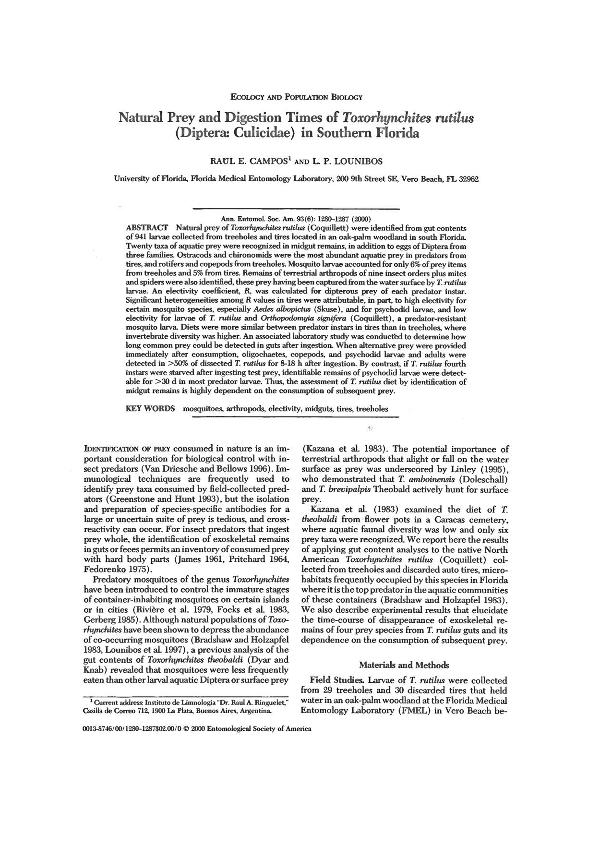Artículo
Natural Prey and Digestion Times of Toxorhynchites rutilus (Diptera: Culicidae) in Southern Florida
Fecha de publicación:
11/2000
Editorial:
Oxford University Press
Revista:
Annals of the Entomologycal Society of America
ISSN:
0013-8746
Idioma:
Inglés
Tipo de recurso:
Artículo publicado
Clasificación temática:
Resumen
Natural prey of Toxorhynchites rutilus (Coquillett) were identified from gut contents of 941 larvae collected from treeholes and tires located in an oak-palm woodland in south Florida. Twenty taxa of aquatic prey were recognized in midgut remains, in addition to eggs of Diptera from three families. Ostracods and chironomids were the most abundant aquatic prey in predators from tires, and rotifers and copepods from treeholes. Mosquito larvae accounted for only 6% of prey items from treeholes and 5% from tires. Remains of terrestrial arthropods of nine insect orders plus mites and spiders were also identified, these prey having been captured from the water surface by T. rutilus larvae. An electivity coefficient, R, was calculated for dipterous prey of each predator instar. Significant heterogeneities among R values in tires were attributable, in part, to high electivity for certain mosquito species, especially Aedes albopictus (Skuse), and for psychodid larvae, and low electivity for larvae of T. rutilus and Orthopodomyia signifera (Coquillett), a predator-resistant mosquito larva. Diets were more similar between predator instars in tires than in treeholes, where invertebrate diversity was higher. An associated laboratory study was conducted to determine how long common prey could be detected in guts after ingestion. When alternative prey were provided immediately after consumption, oligochaetes, copepods, and psychodid larvae and adults were detected in >50% of dissected T. rutilus for 8-18 h after ingestion. By contrast, if T. rutilus fourth instars were starved after ingesting test prey, identifiable remains of psychodid larvae were detectable for >30 d in most predator larvae. Thus, the assessment of T. rutilus diet by identification of midgut remains is highly dependent on the consumption of subsequent prey.
Archivos asociados
Licencia
Identificadores
Colecciones
Articulos(ILPLA)
Articulos de INST.DE LIMNOLOGIA "DR. RAUL A. RINGUELET"
Articulos de INST.DE LIMNOLOGIA "DR. RAUL A. RINGUELET"
Citación
Campos, Raul Ernesto; Lounibos, L. P.; Natural Prey and Digestion Times of Toxorhynchites rutilus (Diptera: Culicidae) in Southern Florida; Oxford University Press; Annals of the Entomologycal Society of America; 93; 6; 11-2000; 1280-1287
Compartir
Altmétricas




